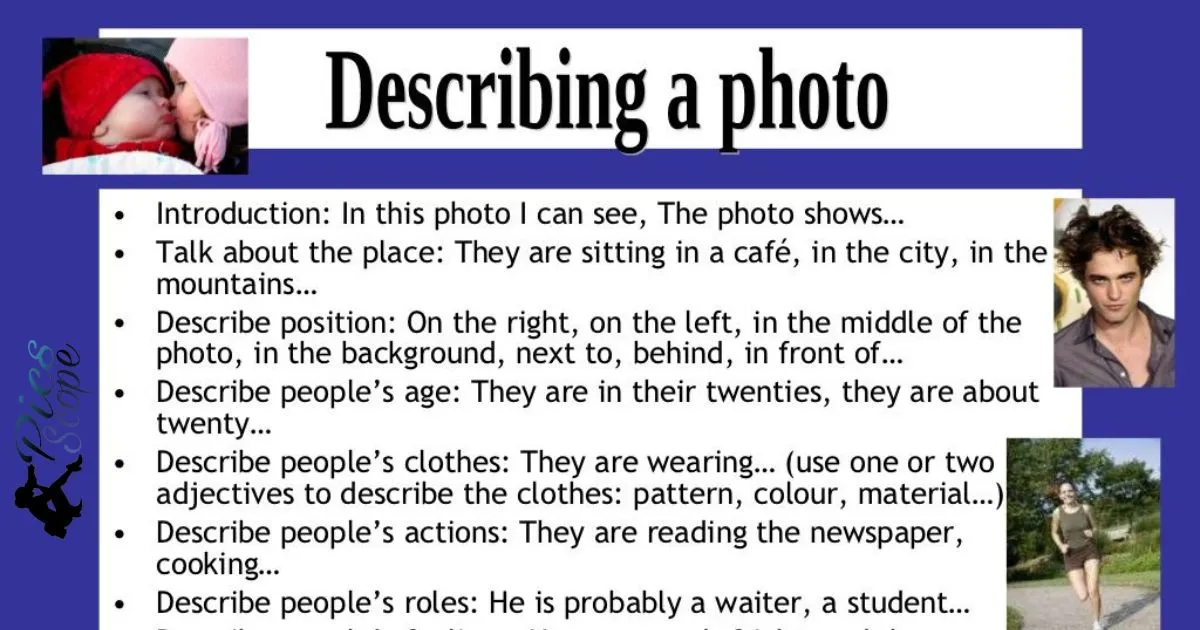Describing your photography means telling others about the types of photos you take and your style. It’s about explaining your vision and passion for capturing images. You talk about your subjects and the messages or feelings you aim to convey through your pictures.
Have you ever been asked “How would you describe your photography?” and struggled to find the right words? Describing your work is important when meeting clients, joining photo groups, or sharing your images on social media. This simple phrase can be challenging yet it is key promoting yourself as a photographer.
To describe your photography well, think about the emotions and stories behind your photos. Consider your influences, favorites genres, and techniques. Keep descriptions concise yet thoughtful. Focus on your photographic voice and vision above technical skills. With practice, you’ll learn to highlight your creativity and uniqueness in just a few sentences.
Understanding Your Photography Style
To understand your photography style, look at the types of photos you enjoy taking most. Do you love capturing landscapes, portraits or street photography? You may also find that you shoot different genres like lifestyle or food photos. Getting clear on the styles that motivate you is key to describing your photography.
Thinking about the genres you prefer can help you define your signature style. While you may experiment across genres, identify your favorites to focus descriptions. Customers and clients will better understand your passions.
Genres Of Photography Do You Enjoy
I especially love taking portraits of people. There is something rewarding about capturing personalities and emotions. Face photos are my main niche because I find people fascinating.
Nature landscapes also attract me. I live near parks and woods, so scenic shots are easy to get. Outside patterns like trees, water or sky offer beauty worth preserving.
Categorize Your Photos
One way to categorize my photos would be by subject matter. I could group shots into people, nature, architecture and lifestyle categories. This gives viewers a quick idea of the types of scenes I capture.
Mood or feeling is another way to organize images. Photos that convey joy, peace or energy through facial expressions or colors could promote my ability to set a certain tone.
Techniques Define Your Photos
Many of my photos have a natural, Market Your Photography Business candid style since I prefer capturing spontaneous moments. I like for subjects to appear relaxed and comfortable in front of my lens.
Lighting also influences my look. Whether it’s shadows, sunbeams or open shade, I try framing shots to highlight interesting light and colors. Paying attention to lighting helps set a visual tone.
Artists Inspire Your Photography
Two photographers who inspire me are Annie Leibovitz for her ability to elicit emotion in portraits and Ansel Adams with his stunning Black and White landscapes. I try bringing some of their compositional skills to my own work.
Other artists whose styles I admire include acclaimed nature photographers like Galen Rowell who capture untamed wilderness gracefully yet powerfully through unique perspectives. Studying masters cultivates my growing skills.
Promoting Your Photography Online

When sharing photos on social media, keep descriptions brief yet touching on essentials. Use a few keywords about the setting, subjects, theme or emotions to give context without long paragraphs. Visuals should do most of the highlighting for you.
Hashtags on platforms like Instagram are key for anyone marketing their photography online. Relevant, popular hashtags group your photos with similar content, increasing visibility to potential customers. Be strategic in hashtag selection.
You Describe Your Photos On Social Media
For online sharing, I keep captions brief-a sentence or two at most. I’ll identify the subject and location plus one detail about light, mood or story behind the shot to engage viewers. Less is more on crowded feeds.
Consistent, concise descriptions showcase my photographic style at a glance even on small mobile previews without overwriting the impact of the photo itself.
Words Best Capture Your Photographic Voice
Adjectives play an important role in conveying my personality as a photographer. Words like “whimsical”, “inspiring”, or “captivating” capture my goal of creating images that transport viewers.
Nouns related to my typical subject matter and settings also fit my voice. Terms for “nature”, “travel” or “portraits” fit without labels seeming too generic when paired with specifics.
Hashtags Help Market Your Photography
On Instagram, popular hashtags help potential customers find my work by tying photos to common searches. For landscapes, I’ve found general ones like earth official or more targeted like scenic connecticut effective.
Niche hashtags for common subjects keep engaged communities coming back to new posts. This friendly competition increases reach beyond my own followers. Regular use boosts discoverability.
Descriptions Drive Traffic To Your Website
Directing curious social media viewers to my full portfolio on my website is key. I include a website URL and a brief invitation to see more of my photography there. Interested clients and art buyers may reach out after browsing further.
Consistently referencing my website where I host blog posts and inquire about services lets casual social media fans become serious potential customers with one click beyond platforms. Descriptions promote new opportunities.
FINDING WORDS TO DESCRIBE YOUR PHOTOGRAPHY: HOW TO GUIDE
When describing your photography, start by observing. Look at the colors, shapes, and emotions in your photo. Then, choose words that capture what you see and feel.
Think about the story behind your photo. Consider the mood it conveys and the message you want to share. Use descriptive language to paint a vivid picture for your audience, guiding them through your photographic journey. By taking these steps, you can effectively communicate the essence of your photography to others.
Describing Your Photography To Clients
When meeting with clients, highlight your style, subjects and services to help them envision collaborating. Keep descriptions tailored for different projects like headshots, events or products. This demonstrates versatility for various needs.
Showcasing your full range of work establishes you as a professional for any visual concepts. Potential repeat customers may refer you further once aware of your skills and passion.
Potential Clients Want To Know About Your Photography
Clients typically want to understand your experience level, style preferences and pricing options. They also look for insight into how you would approach their specific assignment based on provided details or locations. Addressing these practical questions efficiently builds trust.
Knowing a few of your favorite past projects lets clients visualize the quality and creativity you offer across genres. Showing your problem-solving abilities prepares them for a smooth shoot.
You Showcase Your Style With Portfolio Descriptions
I highlight tone, lighting, composition and subjects when labeling portfolio samples. For headshots, I note my ability to capture energy with soft window light. Product shots show tricks for drawing eyes to key details.
Clients see at a glance how various types of commissions could look with my touch. They benefit from understanding my vision before deciding if it suits their goals.
Photography Services Do You Offer Clients

5 tips for describing photography services to clients
Specify Packages
Offer basic/standard, premium and deluxe package options with clear inclusions.
Highlight Your Process
Outline the production steps from booking to delivery in simple terms.
Emphasize Equipment
Note your professional camera/lens gear to build confidence in quality.
Share an Example
Link to a free sample gallery they can view for a taste of your style.
Quote Pricing Clearly
Provide upfront pricing or per hour rates to set expectations upfront.
Descriptions Help Clients Choose You
Conveying an identifiable style early lets potential buyers decide if my artistic eye aligns with their company values or personal tastes. Descriptions save their time sorting through unsuitable options.
Offering transparent, tailored service details sets suitable expectations from the contract phase onward. Clients hire with confidence, knowing what to expect from start to finish.
Telling The Story Behind Your Photographs
Some of my photos capture fleeting expressions that say so much without words. By explaining observed interactions or the history behind a setting, I shed light on these silent narratives for interested viewers.
Bringing the unseen emotional context to life engages audience imagination. It celebrates photography’s potential to preserve meaningful moments across environments.
You Convey Emotions And Themes In Your Photos
Whether joy, sadness or intimacy, I aim photographs at conveying universal feelings through subtle nonverbal clues. Smiling eyes, glancing touches and body language speak volumes with creative framing.
Pairs or groups highlighting forgotten interactions between subjects often intrigue most. Focusing descriptions on these human dynamics motivates further inspection.
Your Photos Best Represent Your Vision
One image taken during golden hour perfectly captures my love of natural light and simple rural landscapes. The warm glow and open field communicate my goal of sharing beauty in everyday scenes.
For portraits, a candid shot of a laughing child surrounded by falling leaves shows my ability to seize fleeting expressions. Her joy is contagious, like the photographs I strive to produce.
Inspired You To Take Specific Photographs
| Photograph | Inspiration |
| Sunset landscape | I wanted to capture the beautiful colors in the sky at dusk. |
| Family portrait | Our family reunion inspired me to photograph everyone together. |
| City skyline | The tall buildings and lights at night inspired awe and made for an interesting photo. |
| Wildflowers | I was inspired by the explosion of color from the flowers in the field during spring. |
| Snowy trees | The magic of fresh snowfall on bare tree branches caught my eye and inspired the shot. |
| Portrait of a friend | My friend’s smile and laughter inspired me to take her photo during our fun night out. |
| Pet photos | My dog’s playful personality inspired spontaneous photos of her. |
| Food still life | Delicious meal prep inspired photos of colorful ingredients and prepared dishes. |
| Waterfall | The peaceful setting by the waterfall inspired a moody landscape photo. |
You Engage Viewers With Descriptions
Rather than just identify technical data, I aim descriptions at painting a picture with words. By highlighting what first caught my eye or elicited an emotional response, I invite viewers on the creative journey with me.
Relating personal anecdotes brings photographs to life beyond their frames. It celebrates the power of visual storytelling to connect across experiences.
Refining Your Photography Descriptions

As my style evolves, I revisit past catalogues to refine labels. Updated summaries reflecting my advancing skills keep portfolios attractive to new clients over the long run.
Watching how descriptions impact engagement also offers clues for enhancement. Paying attention to viewer behavior guides targeted improvements.
You Improve Your Photography Descriptions Over Time
Listening to constructive criticism highlights weak points. Phrases that confused or lacked visual cues present opportunity. I welcome opinions on readability and brand consistency.
Drawing from feedback, descriptors gain clarity and cohesiveness reflecting my matured abilities. Customers appreciate consistent, fully representative previews.
Feedback Can Help Strengthen Your Descriptions
Asking other photographers to evaluate captions broadens perspective. Their industry experience catches lapses in specificity. Non-photographers also offer fresh eyes for cross-promoting to new audiences.
Testimonials note descriptions aiding sale decisions, giving real data to strengthen highlighted benefits. Iterative changes yield optimal storytelling.
Will Practice Help You Define Your Photography
Only with time capturing diverse assignments do deeper interests emerge. Experimenting expands repertoires, and evaluating complete projects reveals favored techniques.
Repetition refines capturing emotions and lighting efficiently. Mastery inspires confidence promoting nuanced styles. Handling various challenges cements my creative definition.
Outlets Offer Guidance On Photography Descriptions
Photography publications and blogs offer case studies and expert advice. Learning from successful description formats across marketing channels optimizes my own.
Style guides, academic resources and booking conference workshops also educate on productive caption structures. Ongoing education fuels strategic promotion skills.
Frequently Asked Question
What Style Best Defines My Photos?
Find simple adjectives that capture your visual approach such as minimalist, vibrant colors, storytelling, candid moments.
How Do I Describe My Subjects?
Focus on your typical subject matter like landscapes, portraits, pets. Mention if you specialize in events, weddings or other genres.
What Equipment Do I Use?
Listing your camera, lenses and other gear helps potential clients understand your capabilities and production quality.
Where Can People See My Work?
Provide website and social media links to easily view a portfolio highlighting your skills and artistic vision.
How Do I Price My Services?
Give a brief overview of your pricing structures for sessions, packages and prints. Note additional costs like locations fees if relevant.
Conclusion
Photography is a creative outlet that allows you to express yourself visually. When describing your style and work to others, it is important to highlight the aspects that make your photography unique. Focus on the themes, subjects, moods, and techniques that you frequently use to capture photographs.
Discuss the technical skills you have developed with your camera equipment and photo editing software. Showcase samples that best represent your artistic vision and expertise. To stand out, tell the visual stories behind your photos and connect with your audience.
Emphasize the inspiration and passion you bring to each shot. Your goal is to give viewers insight into your photographic perspective and voice. In the end, authentically sharing what inspires you creatively and draws you to images will help others understand your photography and connect with your work on a deeper level.







